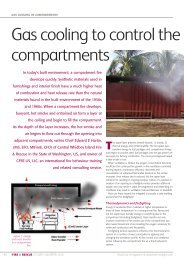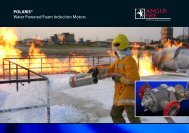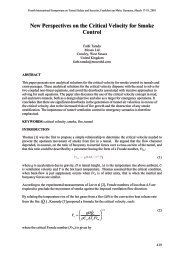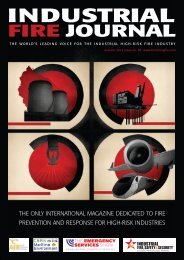CSB presentation - Industrial Fire Journal
CSB presentation - Industrial Fire Journal
CSB presentation - Industrial Fire Journal
Create successful ePaper yourself
Turn your PDF publications into a flip-book with our unique Google optimized e-Paper software.
Public Meeting November 16, 2011<br />
Hoeganaes Corporation<br />
Iron Dust Flash <strong>Fire</strong>s and<br />
Hydrogen Explosion<br />
Gallatin, Tennessee<br />
January 31, 2011<br />
March 29, 2011<br />
May 27, 2011
Investigation Team<br />
Johnnie Banks<br />
Investigations Team Lead<br />
David Chicca<br />
Maria Mazzocchi<br />
Marc Sáenz<br />
Lucy Tyler<br />
2<br />
www.csb.gov
Meeting Agenda<br />
Investigation Team Presentation<br />
Board Questions<br />
Panel Discussion<br />
Questions for Panelists<br />
Public Comment<br />
Other <strong>CSB</strong> Business<br />
Closing<br />
3<br />
www.csb.gov
Meeting Purpose<br />
<br />
Three incidents at the Gallatin<br />
facility<br />
Provide feedback and technical<br />
information to the community<br />
Present findings to the board<br />
Introduce recommendations<br />
4<br />
www.csb.gov
Investigation Team Presentation<br />
Company Overview<br />
Facility and Process overview<br />
Incident Animations<br />
Investigation Findings<br />
Staff Proposed Recommendations<br />
6<br />
www.csb.gov
Company Overview<br />
Worldwide producer of atomized<br />
steel and iron powders<br />
Facilities in the US, Germany, China<br />
and Romania<br />
Headquartered in Cinnaminson, NJ<br />
Subsidiary of GKN<br />
British multinational engineering<br />
company<br />
GKN acquired Hoeganaes in 1999<br />
7<br />
www.csb.gov
Hoeganaes Gallatin, TN Facility<br />
30 miles northeast<br />
of Nashville, TN<br />
~180 workers<br />
Became operational<br />
in the 1980s<br />
Significant<br />
production<br />
increases<br />
8<br />
www.csb.gov
Powdered Metal Process<br />
Hoeganaes receives and melts<br />
scrap steel to meet customer<br />
specifications<br />
The molten iron is sprayed and<br />
cooled into a coarse powder<br />
Processed in annealing furnaces<br />
with hydrogen<br />
Crushed and milled into fine<br />
powdered metal product<br />
9<br />
www.csb.gov
Incident Illustration<br />
Bucket Elevator Flash <strong>Fire</strong><br />
January 31, 2011<br />
2 Fatalities
Bucket Elevator Flash <strong>Fire</strong><br />
11<br />
www.csb.gov
Bucket Elevator Flash <strong>Fire</strong><br />
Significant accumulations of iron<br />
powder on flat surfaces<br />
Bucket elevator dust collection<br />
system was out of service<br />
Elevator motor had exposed wiring<br />
and was not properly grounded<br />
12<br />
www.csb.gov
Incident Illustration<br />
Band Furnace Flash <strong>Fire</strong><br />
March 29, 2011<br />
1 injury
Hydrogen Explosion &<br />
Secondary Dust Flash <strong>Fire</strong>s<br />
14<br />
www.csb.gov
Band Furnace Flash <strong>Fire</strong><br />
Significant accumulations of iron<br />
powder on above surfaces lofted<br />
during maintenance activity<br />
Several ignition sources nearby<br />
Dust cloud formed next to a openflamed<br />
furnace<br />
15<br />
www.csb.gov
Incident Illustration<br />
Hydrogen Explosion and<br />
Secondary Iron Dust<br />
Flash <strong>Fire</strong>s<br />
May 27, 2011<br />
3 fatalities, 2 injuries
17<br />
www.csb.gov
Hydrogen Explosion &<br />
Secondary Dust Flash <strong>Fire</strong>s<br />
The presence of hydrogen in the<br />
band furnace removes oxygen<br />
from the iron<br />
Delivered to the furnaces via pipes<br />
in an underground trench<br />
Hydrogen is supplied to<br />
Hoeganaes by an adjacent<br />
company<br />
18<br />
www.csb.gov
Hydrogen Explosion &<br />
Secondary Dust Flash <strong>Fire</strong>s<br />
Hydrogen leak caused by corroded<br />
hydrogen piping<br />
No system in place to ensure<br />
hydrogen piping is inspected and<br />
maintained<br />
Flammable gas testing was not<br />
performed prior to opening the<br />
hydrogen pipe trench near several<br />
ignition sources 19<br />
www.csb.gov
Hydrogen Explosion &<br />
Secondary Dust Flash <strong>Fire</strong>s<br />
No company procedures to<br />
respond to and mitigate suspected<br />
gas leaks<br />
Process area near band furnaces<br />
did not have appropriately rated<br />
electrical equipment for use near<br />
flammable gases<br />
20<br />
www.csb.gov
Hydrogen Explosion &<br />
Secondary Dust Flash <strong>Fire</strong>s<br />
The hydrogen explosion<br />
overpressure lofted and ignited<br />
accumulations of iron powder<br />
21<br />
www.csb.gov
Combustible Dust Testing
23<br />
www.csb.gov
Combustible Dust Testing<br />
Iron powder was the fuel source<br />
for the January and March 2011<br />
incidents<br />
The May 2011 hydrogen explosion<br />
lofted and ignited accumulated<br />
iron powder on elevated surfaces<br />
The <strong>CSB</strong> collected samples of iron<br />
powder at the Hoeganaes facility<br />
for laboratory testing<br />
24<br />
www.csb.gov
Iron Dust Combustibility<br />
Demonstration
26<br />
www.csb.gov
Combustible Dust Testing<br />
<strong>CSB</strong> commissioned laboratory<br />
testing to determine Hoeganaes<br />
dust explosibility<br />
20 Liter (20L)Test Method, as<br />
specified by NFPA 484<br />
1 meter cubed (1m 3 ) Test Method<br />
Laboratory tests can predict how<br />
dusts can behave when dispersed<br />
near an ignition source<br />
27<br />
www.csb.gov
Combustible Dust Testing<br />
Property Definition Application<br />
K st<br />
P max<br />
Explosion Severity<br />
(ES)<br />
Pressure Ratio<br />
(PR)<br />
Dust deflagration<br />
index<br />
(bar m/s)<br />
Maximum explosion<br />
overpressure<br />
generated in a test<br />
chamber (bar)<br />
Calculated value<br />
normalized to<br />
Pittsburgh coal dust;<br />
Class II test<br />
Calculated value;<br />
explosibility screening<br />
test<br />
Measures the relative<br />
explosion severity<br />
compared to other<br />
dusts<br />
Used to design<br />
enclosures and<br />
predict severity of the<br />
consequence<br />
Determines if Class II<br />
electrical equipment<br />
is needed<br />
Determines if a dust<br />
is explosible<br />
28<br />
www.csb.gov
Iron Powder Test Results<br />
Bag house #4 sample<br />
(as received)<br />
Explosible ?<br />
(Pressure Ratio Calculation)<br />
Ignitable?<br />
Result<br />
Yes<br />
Yes<br />
K st (bar m/s) 19<br />
P max (bar) 3.5<br />
*The <strong>CSB</strong> also conducted 1m 3 testing from a different<br />
sample with a larger particle size; this did not ignite in<br />
the 1m 3 chamber<br />
29<br />
www.csb.gov
Combustible Dust Testing<br />
Dust testing results concluded that<br />
the iron powder at Hoeganaes is<br />
combustible and presents a<br />
serious flash fire hazard<br />
30<br />
www.csb.gov
Hoeganaes Combustible Dust<br />
Testing<br />
Prior testing in 2009 and 2010<br />
performed by Hoeganaes as a<br />
result of an insurance audit<br />
recommendation<br />
Testing results concluded that<br />
dust was explosible<br />
Hoeganaes testing results similar<br />
to <strong>CSB</strong> commissioned test results<br />
31<br />
www.csb.gov
Industry Dust Hazard Recognition<br />
Metal dust hazards have been<br />
known and discussed throughout<br />
industry since the 1940s<br />
In addition to Hoeganaes, the <strong>CSB</strong><br />
investigated 5 combustible dust<br />
incidents<br />
32<br />
www.csb.gov
Other <strong>CSB</strong> Dust Investigations<br />
Investigation Year Material # of<br />
fatalities<br />
West Pharmaceutical<br />
Services<br />
2003 Polyethylene<br />
powder<br />
CTA Acoustics 2003 Phenolic resin 7<br />
6<br />
Hayes Lemmerz<br />
International<br />
2003 Aluminum<br />
dust<br />
Imperial Sugar 2008 Sugar dust 14<br />
1<br />
AL Solutions 2010 Titanium<br />
powder<br />
3<br />
33<br />
www.csb.gov
<strong>CSB</strong> Dust Study Data<br />
The <strong>CSB</strong> issued a Combustible<br />
Dust Hazard Study in 2006<br />
Identified 281 dust fires and<br />
explosions between 1980 and 2005<br />
119 fatalities<br />
718 injuries<br />
20% of dust fires and explosions<br />
were fueled by metal dusts<br />
34<br />
www.csb.gov
Hoeganaes Past Incidents<br />
Previous explosion and fire<br />
incident occurred at the<br />
Hoeganaes Riverton, NJ facility in<br />
1992<br />
One worker severely burned; died 2<br />
years later<br />
In 1996, an iron dust fire in a dust<br />
collector at the Gallatin facility<br />
One worker injured<br />
35<br />
www.csb.gov
Hoeganaes Past Incidents<br />
Workers told <strong>CSB</strong> investigators<br />
there were multiple small dust<br />
flash fires at the Gallatin facility<br />
that did not result in any injuries<br />
Hoeganaes did not mitigate the<br />
hazard<br />
Operators were forced to tolerate<br />
conditions at the facility<br />
No training to understand the<br />
potential for iron dust flash fires 36<br />
www.csb.gov
Hierarchy of Controls
Hierarchy of Controls<br />
Concept recognized by health and<br />
safety professionals to control<br />
workplace hazards<br />
Developed by the National Safety<br />
Council in the 1940s<br />
Adopted into OSH Act of 1970<br />
Hierarchical order of control<br />
methods to prevent or mitigate<br />
worker injury or exposure<br />
38<br />
www.csb.gov
Hierarchy of Controls<br />
CONTROL EFFECTIVENESS<br />
Inherently Safer Technologies (IST)<br />
Engineering Controls<br />
Administrative<br />
Controls<br />
PPE<br />
39<br />
www.csb.gov
Hierarchy of Controls<br />
Inherently Safer Technologies (IST)<br />
Avoids hazards<br />
instead of<br />
controlling<br />
hazards<br />
Engineering Controls<br />
Administrative<br />
Controls<br />
PPE<br />
Eliminate the<br />
hazard during<br />
design<br />
Substitution<br />
of less<br />
hazardous<br />
materials or<br />
equipment<br />
40<br />
www.csb.gov
Hierarchy of Controls<br />
Engineering Controls<br />
Design options<br />
that<br />
automatically<br />
reduce risk<br />
Administrative<br />
Controls<br />
PPE<br />
Well-sealed<br />
powder conveyance<br />
systems<br />
Appropriately<br />
sized dust<br />
collection<br />
Elimination of<br />
ignition sources<br />
41<br />
www.csb.gov
Hierarchy of Controls<br />
Engineering Controls<br />
Procedures,<br />
training, or<br />
work practices<br />
to manage the<br />
hazard<br />
Administrative<br />
Controls<br />
PPE<br />
Housekeeping<br />
Flammable gas<br />
monitoring<br />
Preventive<br />
maintenance<br />
42<br />
www.csb.gov
Hierarchy of Controls<br />
Engineering Controls<br />
Equipment<br />
worn to shield<br />
worker from<br />
the hazard or<br />
exposure<br />
Administrative<br />
Controls<br />
PPE<br />
Flame resistant<br />
clothing (FRC)<br />
Hard hat<br />
Safety shoes<br />
43<br />
www.csb.gov
Hierarchy of Controls<br />
Engineering controls are<br />
recognized throughout industry as<br />
the preferred method of dust<br />
explosion prevention above<br />
housekeeping and personal<br />
protective equipment (PPE)<br />
Hoeganaes lacked effective and<br />
appropriately maintained<br />
engineering controls to prevent<br />
iron dust accumulations<br />
44<br />
www.csb.gov
Board Questions
Industry Codes and<br />
Standards
Occupational Safety and Health<br />
Administration (OSHA)<br />
Issues and enforces standards and<br />
programs for workplace safety and<br />
health<br />
OSHA Grain Dust Standard (1987)<br />
Grain dust incident fatalities<br />
decreased by 60%<br />
No combustible dust regulation for<br />
general industry<br />
47<br />
www.csb.gov
www.csb.gov<br />
<strong>CSB</strong> Combustible Dust Study<br />
The <strong>CSB</strong> recommended OSHA<br />
promulgate a General Industry<br />
Combustible Dust Regulation after<br />
its 2006 Combustible Dust Study<br />
OSHA issued advanced notice of<br />
rulemaking in 2009<br />
Held various stakeholder meetings<br />
Next meeting in December 2011<br />
No final rule has been published<br />
48
<strong>CSB</strong> Combustible Dust Study<br />
The <strong>CSB</strong> also recommended<br />
OSHA develop a national<br />
emphasis program (NEP) to<br />
address dust while the regulation<br />
was being developed<br />
OSHA issued a Combustible Dust<br />
NEP in October 2007.<br />
49<br />
www.csb.gov
Combustible Dust NEP<br />
Not a regulation<br />
Inspection tool for compliance<br />
officers to apply existing<br />
standards to facilities that handle<br />
dust<br />
Can be applied to all dust<br />
processing operations but<br />
specifically targets certain<br />
industries by industrial<br />
classification codes (NAICS)<br />
50<br />
www.csb.gov
Combustible Dust NEP<br />
The NAICS code for Hoeganaes<br />
was not listed in the NEP as a<br />
targeted industry with dustproducing<br />
operations<br />
51<br />
www.csb.gov
Tennessee OSHA (TOSHA)<br />
Tennessee operates under a State<br />
worker safety plan<br />
States can develop individual<br />
worker safety and health programs<br />
<br />
Federal OSHA standards<br />
Plans approved and monitored by<br />
Federal OSHA<br />
States can also adopt federal<br />
standards and programs<br />
52<br />
www.csb.gov
TOSHA<br />
Tennessee OSHA adopted the<br />
Combustible Dust NEP in 2008<br />
State OSHA plans have the<br />
authority to add industry codes to<br />
the state-adopted NEP<br />
TOSHA did not add the industry<br />
code for Hoeganaes to the<br />
program<br />
Hoeganaes was not inspected for<br />
dust<br />
53<br />
www.csb.gov
National <strong>Fire</strong> Protection<br />
Association (NFPA)<br />
Industry consensus organization<br />
that develops and maintains<br />
standards and codes related to fire<br />
prevention and response<br />
Adopted by federal, state, and<br />
local entities into regulations and<br />
ordinances<br />
Voluntarily adopted by private<br />
companies<br />
54<br />
www.csb.gov
NFPA 484<br />
NFPA 484, Standard for<br />
Combustible Metals contains<br />
provisions for protecting people<br />
and facilities from metal fires and<br />
explosions<br />
Addresses facilities that produce,<br />
handle or store combustible<br />
metals and alloys<br />
55<br />
www.csb.gov
NFPA 484<br />
The authority having jurisdiction<br />
was not required to enforce NFPA<br />
484<br />
City of Gallatin or <strong>Fire</strong> Department<br />
Hoeganaes did not voluntarily<br />
adopt NFPA 484<br />
Had Hoeganaes applied provisions<br />
of NFPA 484, the conditions that<br />
led to these incidents could have<br />
been mitigated.<br />
56<br />
www.csb.gov
NFPA 484<br />
Specifies test methods for<br />
combustible dusts<br />
Addresses various elements of<br />
hierarchy of controls<br />
Design and engineering controls to<br />
prevent dust accumulation<br />
Guidelines for housekeeping<br />
programs<br />
57<br />
www.csb.gov
58<br />
www.csb.gov
International Code Council (ICC)<br />
Member-focused association that<br />
develops codes for public and<br />
industrial safety<br />
Building safety and fire prevention<br />
codes<br />
No regional limitations<br />
ICC Codes are adopted state-wide or<br />
in local jurisdictions in all 50 states<br />
Offers code assistance, certification<br />
and training to members 59<br />
www.csb.gov
www.csb.gov<br />
International <strong>Fire</strong> Code (IFC)<br />
The ICC develops and maintains<br />
the IFC<br />
The IFC establishes minimum<br />
requirements for residential and<br />
industrial fire prevention<br />
Can be adopted and enforced by<br />
local or state jurisdictions<br />
The IFC is adopted by the State of<br />
Tennessee and the City of Gallatin<br />
60
IFC Chapter 22 Combustible<br />
Dust-Producing Operations<br />
Briefly lists general requirements<br />
for preventing dust explosions<br />
Housekeeping<br />
Minimizing combustible dust<br />
accumulations<br />
Sources of ignition<br />
Prohibits activities involving an open<br />
flame where dust is generated,<br />
stored, or handled 61<br />
www.csb.gov
www.csb.gov<br />
IFC Chapter 22 Combustible<br />
Dust-Producing Operations<br />
IFC cites NFPA 484 and other<br />
NFPA dust standards<br />
IFC wording can be interpreted as<br />
voluntary<br />
2204.1 Standards:<br />
authorized<br />
to enforce <br />
NFPA 484 and other NFPA dust<br />
codes and standards<br />
62
IFC Chapter 22 Combustible<br />
Dust-Producing Operations<br />
State of TN specifically excludes<br />
optional or voluntary provisions of<br />
adopted fire codes.<br />
IFC 2006 is adopted by reference<br />
<br />
adopting any provision of the cited<br />
publications which establishes an<br />
optional or recommended, rather<br />
than mandatory, standard or<br />
63<br />
www.csb.gov
IFC Chapter 22 Combustible<br />
Dust-Producing Operations<br />
The City of Gallatin and the<br />
Gallatin <strong>Fire</strong> Department (GFD) are<br />
responsible for enforcing the<br />
requirements of the IFC that<br />
address combustible dust<br />
The GFD did not enforce the<br />
general requirements of the fire<br />
code for combustible dust<br />
64<br />
www.csb.gov
IFC Chapter 22 Combustible<br />
Dust-Producing Operations<br />
GFD inspected the facility 2 weeks<br />
prior to the 3 rd incident in May<br />
2011<br />
Did not recognize iron dust<br />
accumulations as a fire hazard<br />
Did not inspect the facility against<br />
the general requirements of IFC for<br />
combustible dust<br />
65<br />
www.csb.gov
Key Findings
Key Findings<br />
1. Significant accumulations of iron<br />
powder fueled flash fire incidents<br />
2. Hoeganaes management<br />
personnel were aware of metal<br />
powder combustibility hazards but<br />
did not mitigate the hazard<br />
through engineering controls and<br />
housekeeping<br />
67<br />
www.csb.gov
Key Findings<br />
3. Hoeganaes lacked employee<br />
training and procedures for<br />
flammable gas leaks<br />
4. OSHA did not include the Iron and<br />
Steel Mills Industry Classification<br />
Code for Hoeganaes as a targeted<br />
industry for the Combustible Dust<br />
National Emphasis Program (NEP)<br />
68<br />
www.csb.gov
Key Findings<br />
5. The 2006 International <strong>Fire</strong> Code<br />
(IFC), which was adopted by the<br />
City of Gallatin, does not require<br />
jurisdictions to enforce NFPA<br />
standards for the prevention of<br />
dust fires and explosions<br />
6. The State of Tennessee and the<br />
City of Gallatin do not enforce<br />
<br />
standards or practices of the IFC<br />
69<br />
www.csb.gov
Key Findings<br />
7. The Gallatin <strong>Fire</strong> Department<br />
inspected the Hoeganaes facility<br />
after the first two iron powder flash<br />
fires and did not address<br />
combustible dust hazards present<br />
at the facility just weeks before the<br />
third fatal hydrogen explosion and<br />
dust flash fire.<br />
70<br />
www.csb.gov
Key Findings<br />
8. Instead of utilizing engineering<br />
and administrative controls such<br />
as dust collection systems and<br />
housekeeping programs,<br />
Hoeganaes relied on FRC to<br />
protect workers from iron dust<br />
flash fires.<br />
71<br />
www.csb.gov
Key Findings<br />
9. GKN and Hoeganaes did not<br />
provide corporate oversight to<br />
ensure the Hoeganaes Gallatin<br />
facility was adequately managing<br />
combustible dusts prior to and<br />
throughout the succession of<br />
serious incidents at the Gallatin<br />
facility.<br />
72<br />
www.csb.gov
Staff Proposed<br />
Recommendations
Recommendations Overview<br />
<br />
Primary tool to improve industrial<br />
safety programs and practices<br />
Federal and state regulatory<br />
improvements<br />
Industry and company practices<br />
Trade association standards and<br />
outreach<br />
74<br />
www.csb.gov
Recommendations Overview<br />
<br />
<br />
<br />
Directly address incident findings and<br />
causes<br />
Focus on management system<br />
improvements to prevent recurrence<br />
Recommendations Dept. monitors<br />
progress and updates status at<br />
www.csb.gov/recommendations<br />
75<br />
www.csb.gov
Staff Proposed<br />
Recommendations
www.csb.gov<br />
Occupational Safety and Health<br />
Administration (OSHA)<br />
1. Develop and publish a proposed<br />
rule for a combustible dust<br />
standard within one year of the<br />
approval of this case study.<br />
2. Ensure that the forthcoming<br />
OSHA Combustible Dust<br />
Standard includes coverage for<br />
combustible metal dust including<br />
iron and steel powders.<br />
77
Occupational Safety and Health<br />
Administration (OSHA)<br />
3. Revise the Combustible Dust<br />
emphasis program to include<br />
facilities that produce, handle,<br />
process, or generate iron and steel<br />
powders or dusts.<br />
78<br />
www.csb.gov
Tennessee OSHA (TOSHA)<br />
4. Revise the combustible dust<br />
emphasis program to include<br />
facilities that produce, handle,<br />
process, or generate iron and steel<br />
powders or dusts.<br />
79<br />
www.csb.gov
Hoeganaes Corporation<br />
5. Conduct periodic independent<br />
audits of the Hoeganaes Gallatin<br />
facility for compliance with the<br />
applicable NFPA codes and<br />
standards for combustible dusts,<br />
electrical classifications,<br />
hydrogen, and flame resistant<br />
clothing.<br />
80<br />
www.csb.gov
Hoeganaes Corporation<br />
6. Develop training materials that<br />
address combustible dust and<br />
plant-specific metal dust hazards<br />
and train all employees and<br />
contractors. Require periodic (e.g.,<br />
annual) refresher training for all<br />
employees and contractors.<br />
81<br />
www.csb.gov
Hoeganaes Corporation<br />
7. Implement a preventive<br />
maintenance program, as well as<br />
leak detection and mitigation<br />
procedures for all flammable gas<br />
piping and processing equipment.<br />
82<br />
www.csb.gov
International Code Council (ICC)<br />
8. Revise IFC Chapter 22,<br />
Combustible Dust Producing<br />
Operations to require mandatory<br />
compliance and enforcement with<br />
the detailed requirements of the<br />
NFPA standards cited in the<br />
chapter.<br />
83<br />
www.csb.gov
Metal Powder Producers<br />
Association (MPPA)<br />
9. Communicate the findings of this<br />
report to all your members, such<br />
as through a safety article in an<br />
upcoming monthly newsletter.<br />
84<br />
www.csb.gov
City of Gallatin, TN<br />
10. Require all facilities covered by<br />
IFC Chapter 22 to conform to NFPA<br />
standards for combustible dusts<br />
including NFPA 484.<br />
85<br />
www.csb.gov
Gallatin <strong>Fire</strong> Department<br />
11. Ensure that all industrial facilities<br />
in the City of Gallatin are inspected<br />
at least annually for compliance<br />
with the International <strong>Fire</strong> Code.<br />
12. Implement a program to ensure<br />
that fire inspectors and response<br />
personnel are trained to recognize<br />
and address combustible dust<br />
hazards.<br />
86<br />
www.csb.gov
Staff Proposed<br />
Recommendations
Board Questions
Panel Discussion
Panelists<br />
Dr. Paul Amyotte, P. Eng.,<br />
Dalhousie University, Nova Scotia<br />
Dr. Robert Zalosh<br />
President, <strong>Fire</strong>xplo<br />
NFPA 484 Committee Member<br />
John M. Cholin, P.E., FSFPE,<br />
M.E.E,<br />
President, J.M Cholin Consultants,<br />
Inc.<br />
90<br />
www.csb.gov
Panelists<br />
Guy Colonna<br />
Division Manager, NFPA<br />
Bruce E. Johnson<br />
Director of <strong>Fire</strong> Service Activities,<br />
ICC<br />
Tammy Miser<br />
Founder, United Support and<br />
Memorial for Workplace Fatalities<br />
91<br />
www.csb.gov
Public Comment
U.S. Chemical Safety Board<br />
2175 K St. NW Suite 400<br />
Washington, DC 20037<br />
202-261-7600<br />
www.csb.gov
Public Meeting November 16, 2011<br />
Hoeganaes Corporation<br />
Iron Dust Flash <strong>Fire</strong>s and<br />
Hydrogen Explosion<br />
Gallatin, Tennessee<br />
January 31, 2011<br />
March 29, 2011<br />
May 27, 2011


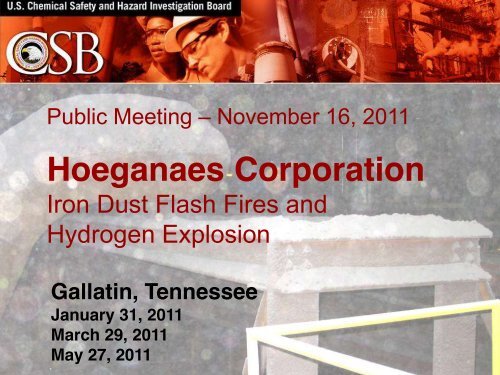
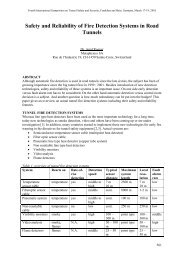
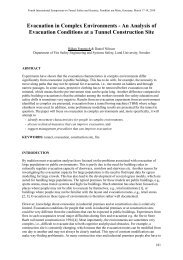

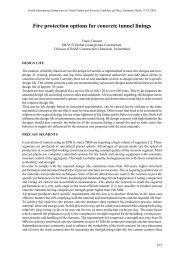
![30-37 TunnelsREV[1]rev.qxd - Industrial Fire Journal](https://img.yumpu.com/22237435/1/184x260/30-37-tunnelsrev1revqxd-industrial-fire-journal.jpg?quality=85)
